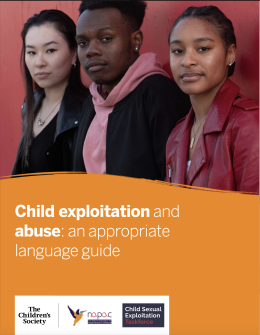Appropriate Language Guide

Every word shapes a life.
When talking about children and exploitation, language matters - it can be the difference between a child being properly safeguarded or put at further risk of exploitation.
This is why new guidance has been published today (Thursday 14 November) by the Child Sexual Exploitation (CSE) Taskforce, who commissioned The Children’s Society and the National Association for People Abused in Childhood (NAPAC) to update an Appropriate Language Guide, which can be used by multi-agency professionals.
Download the 'Child exploitation and abuse: an appropriate language guide' in English.
Download the 'Child exploitation and abuse: an appropriate language guide' in Welsh.
It follows the HMICFRS inspection report on the effectiveness of the police and law enforcement bodies’ response to group-based child sexual exploitation in England and Wales (2023), which recommended that:
"With immediate effect, all chief constables should take effective steps to eradicate victim-blaming language in their forces."
Victim blaming language refers to any language that implies, intentionally or unintentionally, that a victim is responsible for the abuse they have experienced. The language we use is shaped by and normalised within the cultures we work, live, and spend time in. As language evolves, phrases that were once commonly accepted may no longer be appropriate. Therefore, it is crucial to maintain an open and reflective attitude to make sure that our language evolves in a way that supports and respects all individuals.
Supporting Documents
To access further supporting documents and resources, please visit the Children’s Society or NAPAC webpage.
“By using more compassionate and accurate language, professionals can shift the narrative to one of choice and control from one of exploitation and abuse. This promotes better safeguarding practices, ultimately leading to improved support and outcomes for children, which is our shared goal.”
“Sexually abused, forced to steal, carry drugs and launder money, perpetrators are stealing children’s hope and manipulating them into believing it is their own fault.
“Despite some signs of progress, all too often the professionals these children encounter reinforce that they are to blame for their abuse, labelled as troublemakers, complicit, or told that they should have made different ‘choices’. But children cannot choose whether they experience abuse.
“We are therefore pleased to have been able to work with colleagues at NAPAC and within law enforcement to produce this vital resource and take a significant step to ensuring victim blaming becomes a thing of the past."
“Professionals play a crucial role in creating spaces where survivors feel safe and empowered to share their stories – regardless of when they choose to do so. Whether a disclosure comes early in life as a child or many years later, every survivor deserves words that validate their experience and reinforce their sense of safety, dignity, and hope.